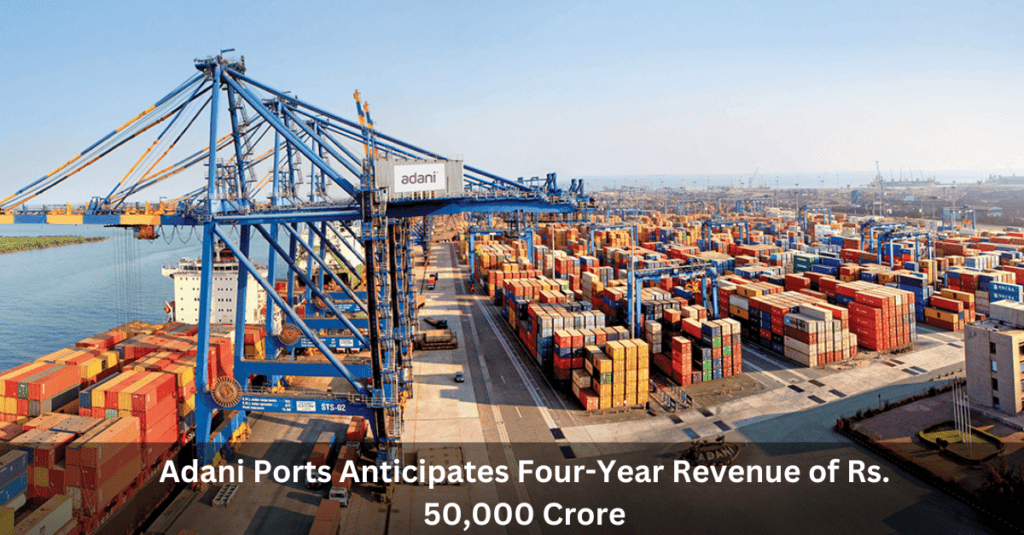In fiscal 2024, Adani Ports and Special Economic Zone Ltd. had better cargo, revenue, and EBITDA results than expected. While net profit increased by 76.87% to Rs 2,014.8 crore in the quarter ending in March, these measures also showed improvement in the same period. Volume growth suggests that their revenue estimate for the fiscal year 2025 is realistic.
The corporation now operates fifteen ports, with Mundra accounting for the maximum overall cargo volumes, down from eighty-nine per cent in the past. Because of this, the West and East coasts now have equal shares; in 2014, the East coast’s portion was zero, but now it’s 43 percent.
Performance Evaluation after Five Years
The port operator anticipated 500 million metric tonnes of cargo in fiscal 2021 and expected to earn Rs 30,000 crore by the conclusion of FY25.
In fiscal year 2024, its income had already surpassed Rs 26,700 crore. Volumes reached 398 million metric tons in 2023. Cargo volumes increased by 20% rather than 17%, which is greater than the CAGR predicted at the beginning of FY21. Additionally, the sales compounded annual growth rate (CAGR) of 29%, which is higher than the expected 24%. In addition, according to Gautam Adani news, EBITDA margins have reached 59% as a result of this great operational performance.
Goal in 2030
A robust increase in cargo volume of 1,000 MMT is the company’s aim for 2030.
The company’s investor presentation predicted that by FY29, its sales will have doubled from its current levels, reaching Rs 50,000 crore, an increase of 16% from FY24. EBITDA growth will drive the strategy, with margins aimed at an impressive 64%.
Already, the corporation is on the cusp of 400 MMT. Its 627 MMT capacity allows for further capacity to be added at a leisurely rate. With a compound annual growth rate (CAGR) of 18%, Adani Ports anticipates cash flow production of Rs 34,500 crore by FY29.
Global Engagement
As per Gautam Adani news, the business has made a concerted effort to expand its activities abroad in recent years. In a joint venture with the Gadot Group, it runs Haifa Port, the biggest port in Israel. India places a high strategic value on this, which it established in 2022. The business announced its privatisation of the port victory in July 2022, saying it had received an offer of NIS 4.1 billion, or $1.18 billion. A 70% ownership share is held by Adani Ports, with the remaining 30% owned by Gadot. The concession runs until 2054.
Its operations and maintenance contracts extend to Tanzania and Australia as well. To put Abbot Point Coal Terminal in Queensland, Australia, into action and keep it running, it has a 99-year lease.
While Sri Lanka will go live this year, it will only add a tiny fraction of the total volume, the business said in its most recent earnings call.
The Biggest Port Operator in India
The firm controls 27% of India’s freight volumes, making it the biggest port operator in the country. In 2013, this accounted for barely 10% of the market. The company claimed operational efficiency, cargo diversification, and business model change drive its growth.
In addition to completing India’s Vizhinjam Port, the company aims to expand capacity at all ports, especially those it has bought recently.
This company’s current assets include of a rail network, trains, grain silos, warehouses, trucks, etc. The corporation has established targets for eight-fold growth in these verticals and has shown substantial growth in all of these assets.
The logistics vertical’s income increased from 600 crore in FY19 to 2,100 crore in FY24. With a 23% rise, EBITDA has gone up from Rs 100 crore to Rs 500 crore. According to Gautam Adani news, revenue and EBITDA are projected to increase at a CAGR of 45% by FY29.
Debt and Credit Rating Matters
It should be noted that the present level of net operational cash flows surpasses the yearly loan repayments. The present foreign debt is at Rs 6,135 crore; the goal is to get it down to zero by FY27 and then raise it from there. Since the expected net operational cash flow from operations will continue to exceed the debt levels until FY41, this will lead to a notable rise in the return ratios until FY27 and beyond.
While the ratio of operational funds to total debt increased from 18% to 28% between March 2022 and the end of FY24, the average duration decreased from seven years to 4.6 years. Between the two points in time, the FFO/interest coverage has gone up from 4.5 to 5.6 times.
Conclusion
Adani Ports’ revenue projection of Rs 50,000 crore over the next four years highlights the company’s robust growth trajectory and strategic expansion plans. This ambitious target highlights Adani Ports’ commitment to enhancing its operational capabilities and expanding its market reach. By leveraging strategic investments in infrastructure, technology, and international partnerships, Adani Ports is poised to capitalise on the increasing demand for efficient logistics and port services. This projection reflects the company’s resilience and adaptability in a competitive market and signals a positive outlook for stakeholders and the broader economic landscape.


